Cheltenham, Gloucestershire
Up to 1834
In about 1730, the Royal Oak inn, at the south side of Cheltenham High Street, was converted for use as a workhouse. In 1776, the establishment could house up to thirty-six inmates. After it burned down in about 1778, premises were leased in Day Lane (now Grove Street). A new workhouse, with a large workshop on its ground floor and accommodation above, was erected in 1789 on a leases site. From 1797, the inmates were employed in the pin-making trade. In 1808, a new purpose-built workhouse opened in the town on what is now Knapp Lane. The following year, to celebrate the golden jubilee of George III, over 100 inmates dined on beef, pudding and strong beer. In 1811, the parish adopted Gilbert's Act.
From around 1808, Coberly's workhouse was located to the west of the village at Booker's Cottages, now a private residence.
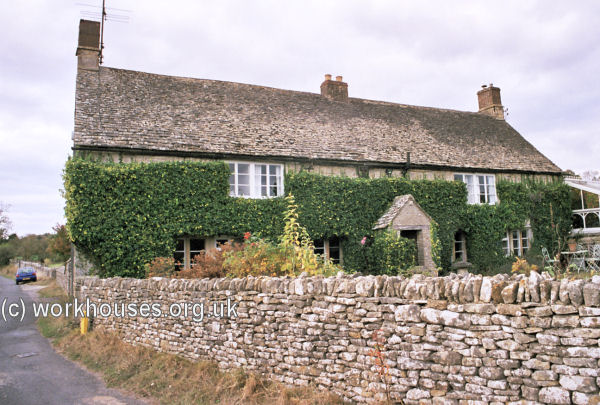
Coberley former parish workhouse, 2003.
© Peter Higginbotham.
In 1824, Prestbury opened a workhouse on Winchcomb Lane, what is now Queenwood Grove.
In 1827, Charlton Kings established a workhouse on Church Street.
After 1834
Cheltenham Poor Law Union was formed on 16th November 1835. Its operation was overseen by an elected Board of Guardians, 27 in number, representing its 13 constituent parishes as listed below (figures in brackets indicate numbers of Guardians if more than one):
County of Gloucester: Badgworth, Charlton Kings, Cheltenham, Cubberley [Coberley], Cowley, Great Whitcombe, Leckhampton, Prestbury, Shurdington, Staverton, Swindon, Uckington, Up Hatherley
The population falling within the Union at the 1831 census had been 29,882 — ranging from Up Hatherley (population 21) to Cheltenham itself (22,942). The average annual poor-rate expenditure for the period 1833-35 had been £5,770 or 3s.10d. per head of the population.
Initially, the new union continued to use the existing torkhouses on Knapp Lane and at Charlton Kings. The old Knapp Lane workhouse, which could hold around 150 inmates, continued in operation until around 1850, after which the property was sold and in 1856 the Parish Church National and Infant Schools were built on the site.
A new union workhouse was ertected in 1838-41 in part of the grounds of The Elms, an old mansion on Swindon Road at the north-west of Cheltenham. The location and layout of the workhouse buildings are shown on the 1903 map below.
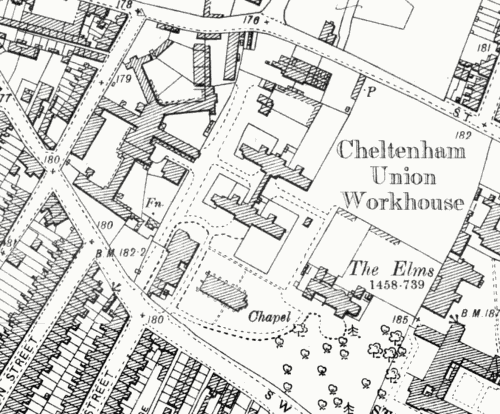
Cheltenham workhouse site, 1903.
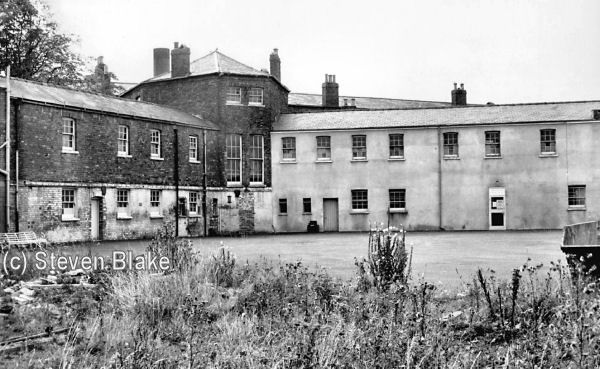
Former Cheltenham workhouse main building from the north, 1978.
Photo by Steven Blake, reproduced with permission.
It was designed by Edward Cope and its eventual layout was an unusual K-shaped formation. Males were housed at the west of the site and females at the east. An entrance block at the south contained the guardians' boardroom and offices. To its rear, a long narrow range, with school rooms on its ground floor, was linked to a central hub from which transverse ranges radiated at each side, with dayrooms on their ground floor and dormitories above. The north side of the hub contained a chapel, perhaps originally also used as a dining-hall. Its north side connected to two further ranges, running to the north-east and north-west, that on the men's side containing the kitchen and a day room, and that on the women's side containing a bake-house and day rooms. At the end of these two ranges were cross-wings housing fever rooms. At the north of the site, a laundry was placed on the women's side, and a stone yard on the men's side. A tramp's ward had an access gate from St Paul's Road. The space between the various wings was divided into exercise yards for the various categories of inmate.
In November 1874, an official inquiry was held at the workhouse into a large number of charges brought against the master and matron of the establishment, Mr and Mrs Welch, namely that they had: inflicted punishment without reporting to the guardians; been absent from house after hours; not visited the men's wards at night; not reported property possessed by deceased paupers; misappropriated property of the guardians; scalded the milk and kept a number of fowls; fed visitors from the workhouse supplies; disposed of lard, and not accounted for money received from the sale of rags and bones; improperly cut up the pigs and kept the best joints preserved; given lumps of fat, cow's udder, lights and pipes to the paupers; used burnt sugar to colour the beef tea; failed to report complaints; bullied the inmates; allowed drunkenness in the house; permitted the officers to not dine together; and given out the officers' rations for the whole day. A subsequent report on the proceedings from the Local Government Board accepted that many of the charges had been proved. Accordingly, the Board of Guardians demanded the immediate resignations of the master and matron.
A chapel was erected at the south-east of the workhouse in about 1886. At around the same time, a casuals' ward block was located at the north-east of the site. A new infirmary complex was built at the east of the workhouse in around 1890.
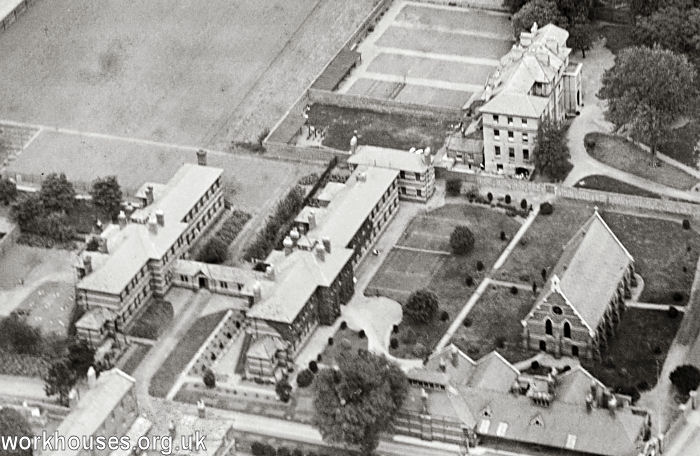
Cheltenham workhouse infirmary and chapel from the west, 1920.
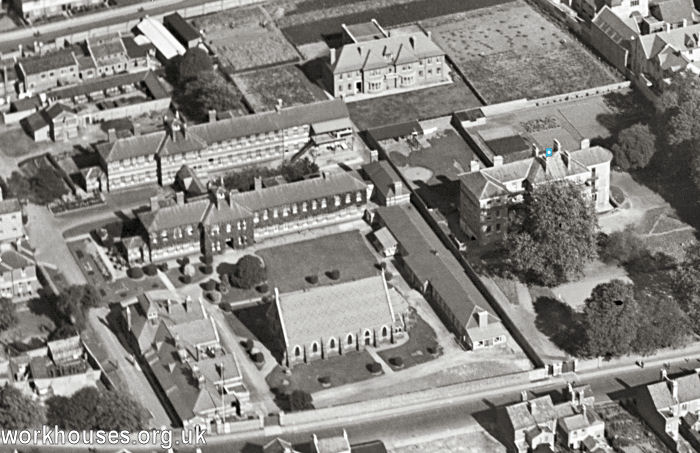
Cheltenham workhouse infirmary and chapel from the south-west, 1932.
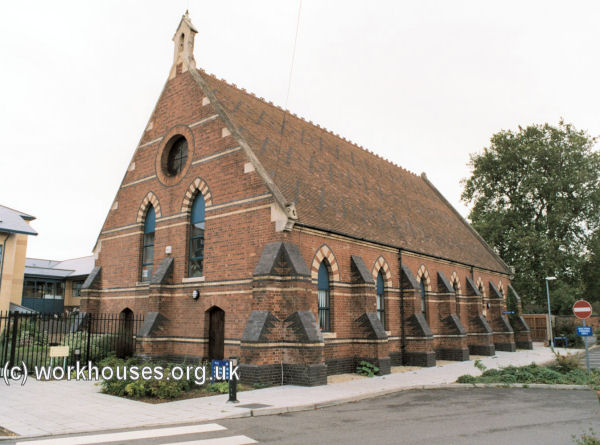
Former Cheltenham workhouse chapel from the south-west, 2001.
© Peter Higginbotham.
From 1904, to help avoid stigma in later life, the birth certificates of those born in the workhouse recorded the location simplay as The Elms, Swindon Road.
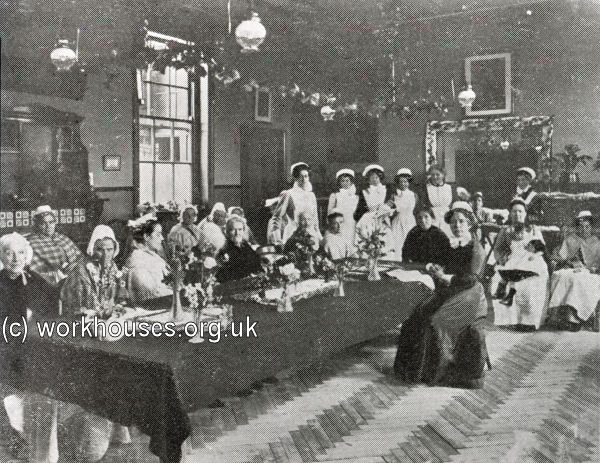
Cheltenham workhouse women's infirmary ward, Christmas 1912.
© Peter Higginbotham.
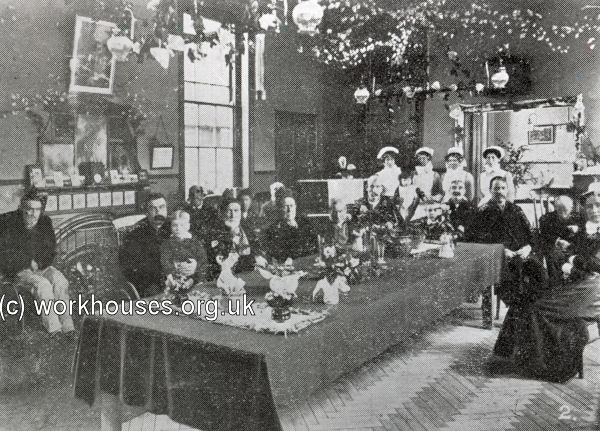
Cheltenham workhouse men's infirmary ward, Christmas 1912.
© Peter Higginbotham.
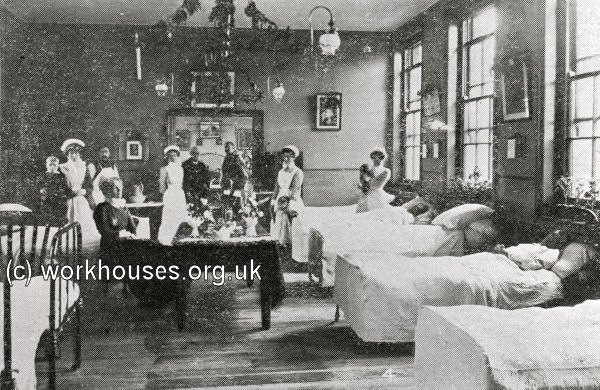
Cheltenham workhouse men's hospital ward, Christmas 1912.
© Peter Higginbotham.
The workhouse later became St Paul's Hospital but this was demolished in the late 1990s, with only the chapel and an outbuilding at the western edge of the site surviving. In more recent times, the site has occupied partly by housing and partly by various health care services.
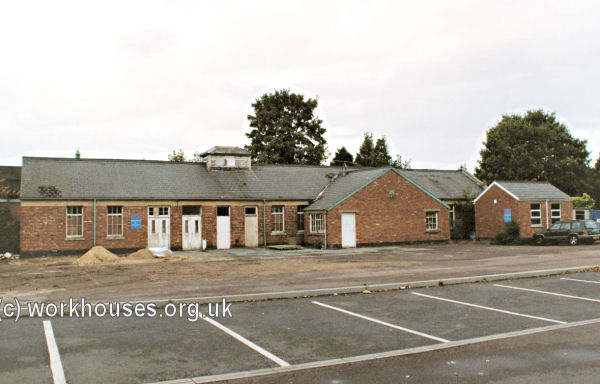
Former Cheltenham workhouse outbuildings from the east, 2001.
© Peter Higginbotham.
The Elms Children's Home
In 1882, the guardians acquired the rest of The Elms site, with the old house then being used as a home for up to 100 pauper children.
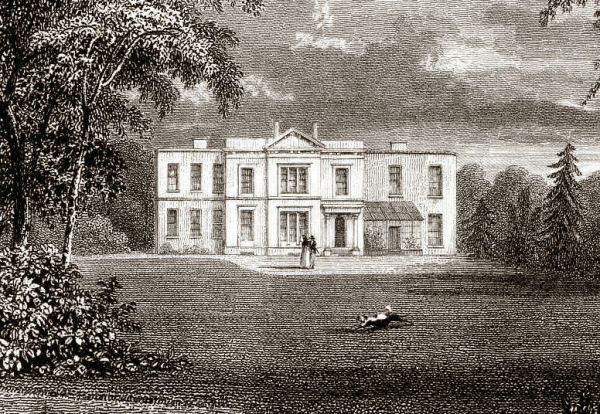
The Elms, Cheltenham, 1820s.
The picture below shows the children in the Elms sitting down to their Christmas dinner in 1912.
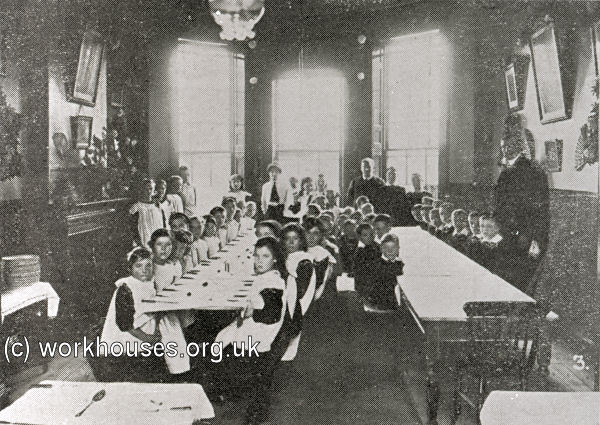
Cheltenham workhouse children in The Elms, Christmas 1912.
© Peter Higginbotham.
The recently appointed master, Mr J.W. Stonier, is standing at the right.
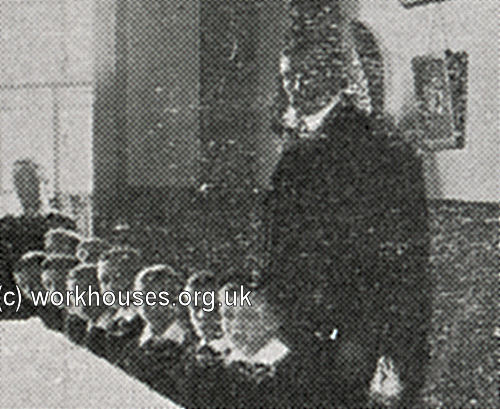
Cheltenham workhouse children in The Elms, Christmas 1912 (detail).
© Peter Higginbotham.
Popes Close now occupies the location.
Staff
Inmates
Records
Note: many repositories impose a closure period of up to 100 years for records identifying individuals. Before travelling a long distance, always check that the records you want to consult will be available.
- Gloucestershire Archives, Clarence Row, Alvin Street, Gloucester GL1 3DW. Holdings include Guardians' minute books (1835-1930); Admissions and discharges (1835-1941, with gaps); Births (1836-56, 1908-14); Deaths (1836-51); Register of inmates (1900-35); Children's home admissions and discharges (1915-38); etc.
Bibliography
- Higginbotham, Peter The Workhouse Encyclopedia (2014, The History Press)
Links
- None.
Unless otherwise indicated, this page () is copyright Peter Higginbotham. Contents may not be reproduced without permission.


